Optimization of Construction Sequence: Productivity and Cost
VerifiedAdded on 2022/11/25
|25
|6506
|246
Report
AI Summary
This report provides a detailed analysis of construction sequence optimization, with a specific focus on improving productivity and cost efficiency within the context of the Western Sydney Airport project. The report begins with an abstract and executive summary, setting the stage for an exploration of the motivation behind the chosen topic, which centers on the critical need for efficient resource allocation and project scheduling in large-scale construction endeavors. The core of the report delves into the methods employed, including a review of the impacts of planning, scheduling, and potential delays, as well as the integration of planning concepts. It then examines the application of the Critical Path Method (CPM) and the Construction Project Scheduling (CPS) approach, outlining planning steps, scheduling procedures, and the outcomes and discussions related to the CPS methodology. The relevance of the optimization approach to the Western Sydney Airport is highlighted, emphasizing the practical application of the proposed techniques. The report concludes with recommendations and self-reflections, offering insights into the practical implementation and future improvements for optimizing construction sequences. This report aims to provide a comprehensive understanding of how to enhance construction projects, reduce costs, and improve overall efficiency.
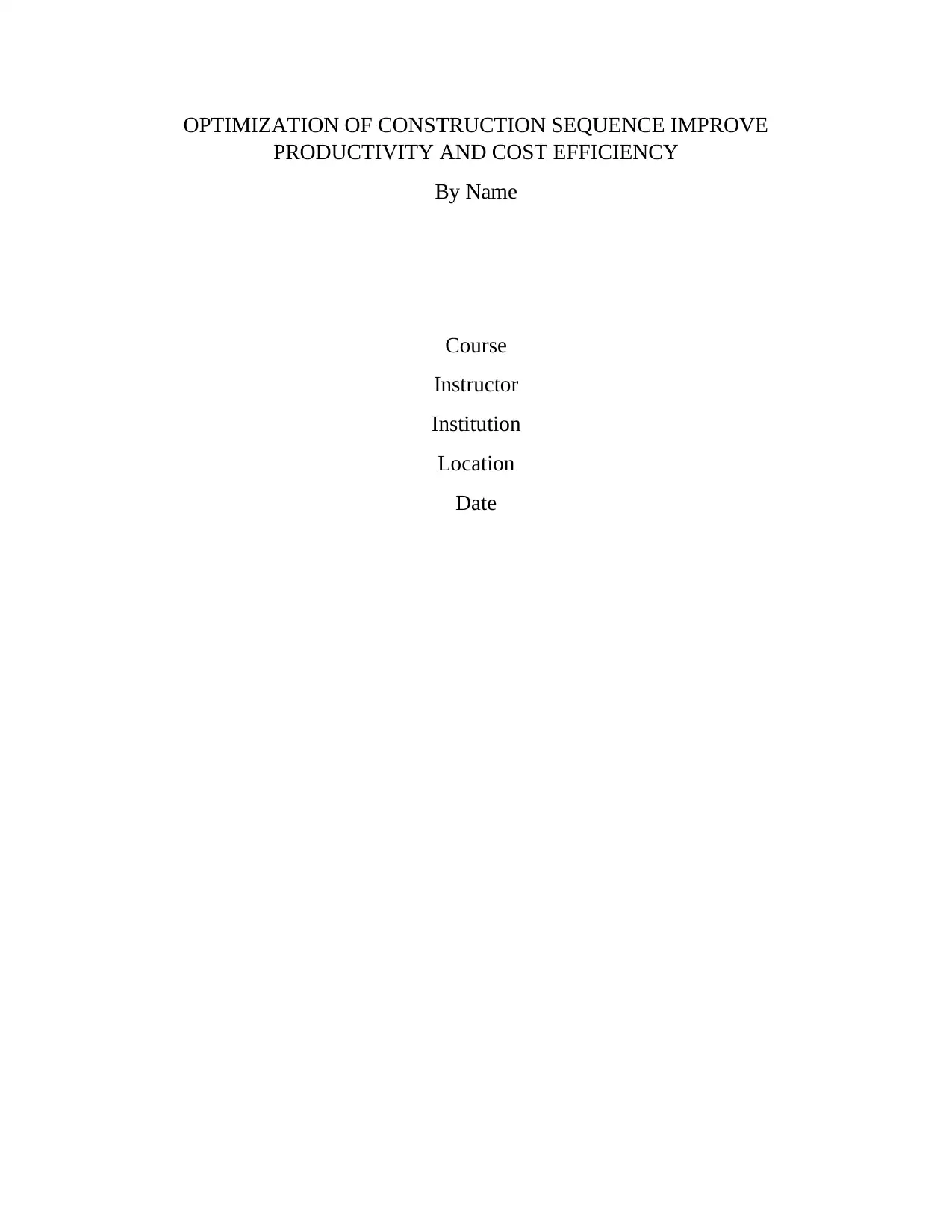
OPTIMIZATION OF CONSTRUCTION SEQUENCE IMPROVE
PRODUCTIVITY AND COST EFFICIENCY
By Name
Course
Instructor
Institution
Location
Date
PRODUCTIVITY AND COST EFFICIENCY
By Name
Course
Instructor
Institution
Location
Date
Paraphrase This Document
Need a fresh take? Get an instant paraphrase of this document with our AI Paraphraser
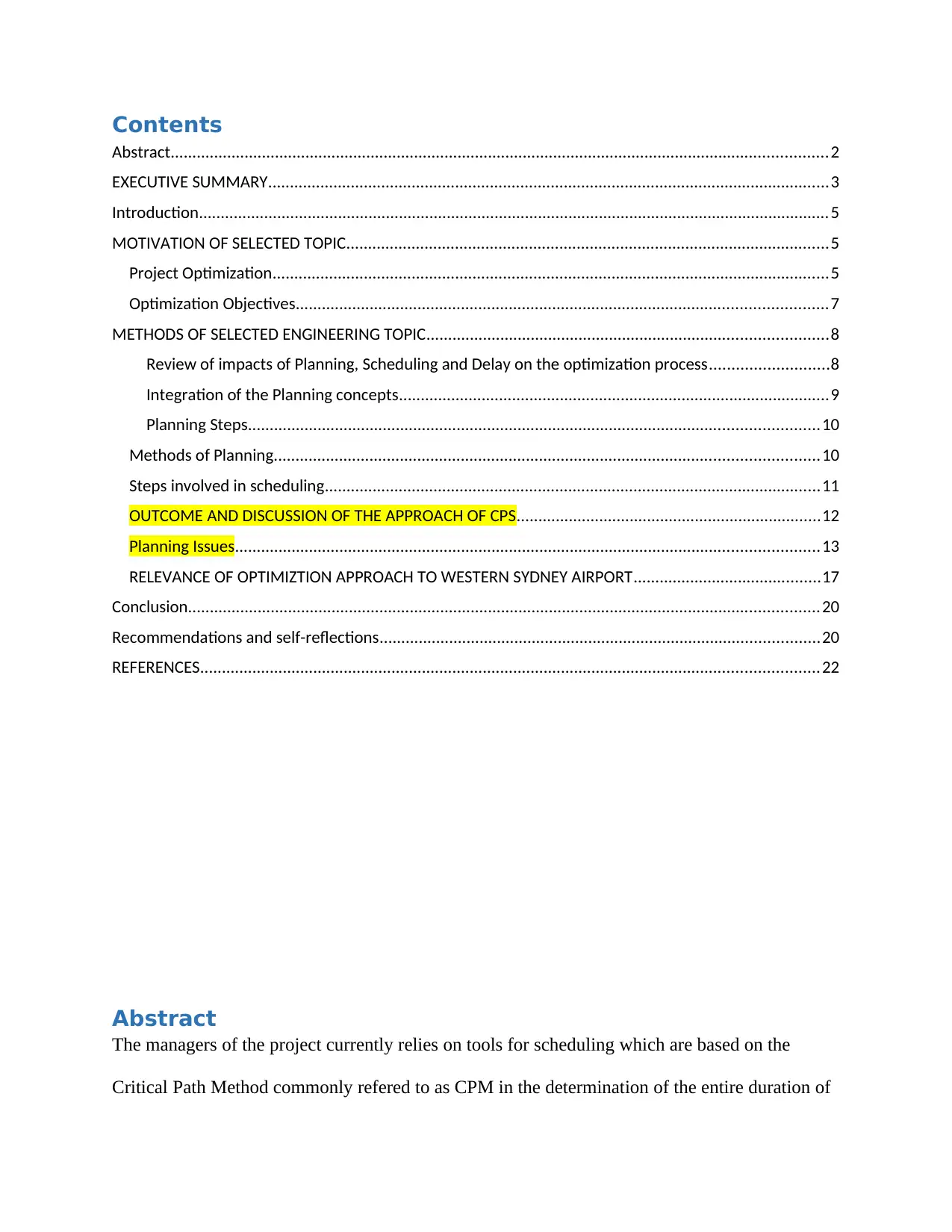
Contents
Abstract.......................................................................................................................................................2
EXECUTIVE SUMMARY.................................................................................................................................3
Introduction.................................................................................................................................................5
MOTIVATION OF SELECTED TOPIC...............................................................................................................5
Project Optimization................................................................................................................................5
Optimization Objectives..........................................................................................................................7
METHODS OF SELECTED ENGINEERING TOPIC............................................................................................8
Review of impacts of Planning, Scheduling and Delay on the optimization process...........................8
Integration of the Planning concepts...................................................................................................9
Planning Steps...................................................................................................................................10
Methods of Planning.............................................................................................................................10
Steps involved in scheduling..................................................................................................................11
OUTCOME AND DISCUSSION OF THE APPROACH OF CPS......................................................................12
Planning Issues......................................................................................................................................13
RELEVANCE OF OPTIMIZTION APPROACH TO WESTERN SYDNEY AIRPORT...........................................17
Conclusion.................................................................................................................................................20
Recommendations and self-reflections.....................................................................................................20
REFERENCES..............................................................................................................................................22
Abstract
The managers of the project currently relies on tools for scheduling which are based on the
Critical Path Method commonly refered to as CPM in the determination of the entire duration of
Abstract.......................................................................................................................................................2
EXECUTIVE SUMMARY.................................................................................................................................3
Introduction.................................................................................................................................................5
MOTIVATION OF SELECTED TOPIC...............................................................................................................5
Project Optimization................................................................................................................................5
Optimization Objectives..........................................................................................................................7
METHODS OF SELECTED ENGINEERING TOPIC............................................................................................8
Review of impacts of Planning, Scheduling and Delay on the optimization process...........................8
Integration of the Planning concepts...................................................................................................9
Planning Steps...................................................................................................................................10
Methods of Planning.............................................................................................................................10
Steps involved in scheduling..................................................................................................................11
OUTCOME AND DISCUSSION OF THE APPROACH OF CPS......................................................................12
Planning Issues......................................................................................................................................13
RELEVANCE OF OPTIMIZTION APPROACH TO WESTERN SYDNEY AIRPORT...........................................17
Conclusion.................................................................................................................................................20
Recommendations and self-reflections.....................................................................................................20
REFERENCES..............................................................................................................................................22
Abstract
The managers of the project currently relies on tools for scheduling which are based on the
Critical Path Method commonly refered to as CPM in the determination of the entire duration of
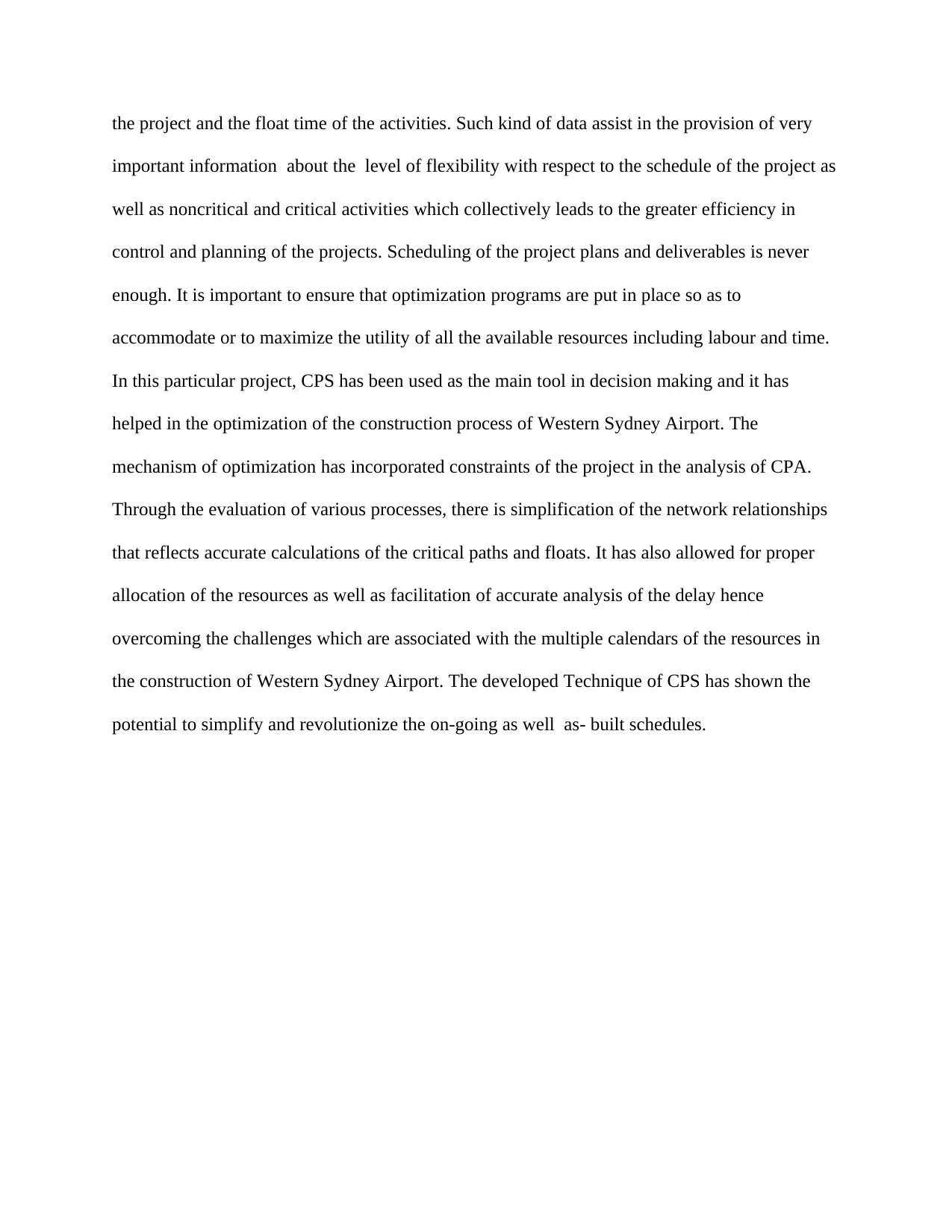
the project and the float time of the activities. Such kind of data assist in the provision of very
important information about the level of flexibility with respect to the schedule of the project as
well as noncritical and critical activities which collectively leads to the greater efficiency in
control and planning of the projects. Scheduling of the project plans and deliverables is never
enough. It is important to ensure that optimization programs are put in place so as to
accommodate or to maximize the utility of all the available resources including labour and time.
In this particular project, CPS has been used as the main tool in decision making and it has
helped in the optimization of the construction process of Western Sydney Airport. The
mechanism of optimization has incorporated constraints of the project in the analysis of CPA.
Through the evaluation of various processes, there is simplification of the network relationships
that reflects accurate calculations of the critical paths and floats. It has also allowed for proper
allocation of the resources as well as facilitation of accurate analysis of the delay hence
overcoming the challenges which are associated with the multiple calendars of the resources in
the construction of Western Sydney Airport. The developed Technique of CPS has shown the
potential to simplify and revolutionize the on-going as well as- built schedules.
important information about the level of flexibility with respect to the schedule of the project as
well as noncritical and critical activities which collectively leads to the greater efficiency in
control and planning of the projects. Scheduling of the project plans and deliverables is never
enough. It is important to ensure that optimization programs are put in place so as to
accommodate or to maximize the utility of all the available resources including labour and time.
In this particular project, CPS has been used as the main tool in decision making and it has
helped in the optimization of the construction process of Western Sydney Airport. The
mechanism of optimization has incorporated constraints of the project in the analysis of CPA.
Through the evaluation of various processes, there is simplification of the network relationships
that reflects accurate calculations of the critical paths and floats. It has also allowed for proper
allocation of the resources as well as facilitation of accurate analysis of the delay hence
overcoming the challenges which are associated with the multiple calendars of the resources in
the construction of Western Sydney Airport. The developed Technique of CPS has shown the
potential to simplify and revolutionize the on-going as well as- built schedules.
⊘ This is a preview!⊘
Do you want full access?
Subscribe today to unlock all pages.

Trusted by 1+ million students worldwide
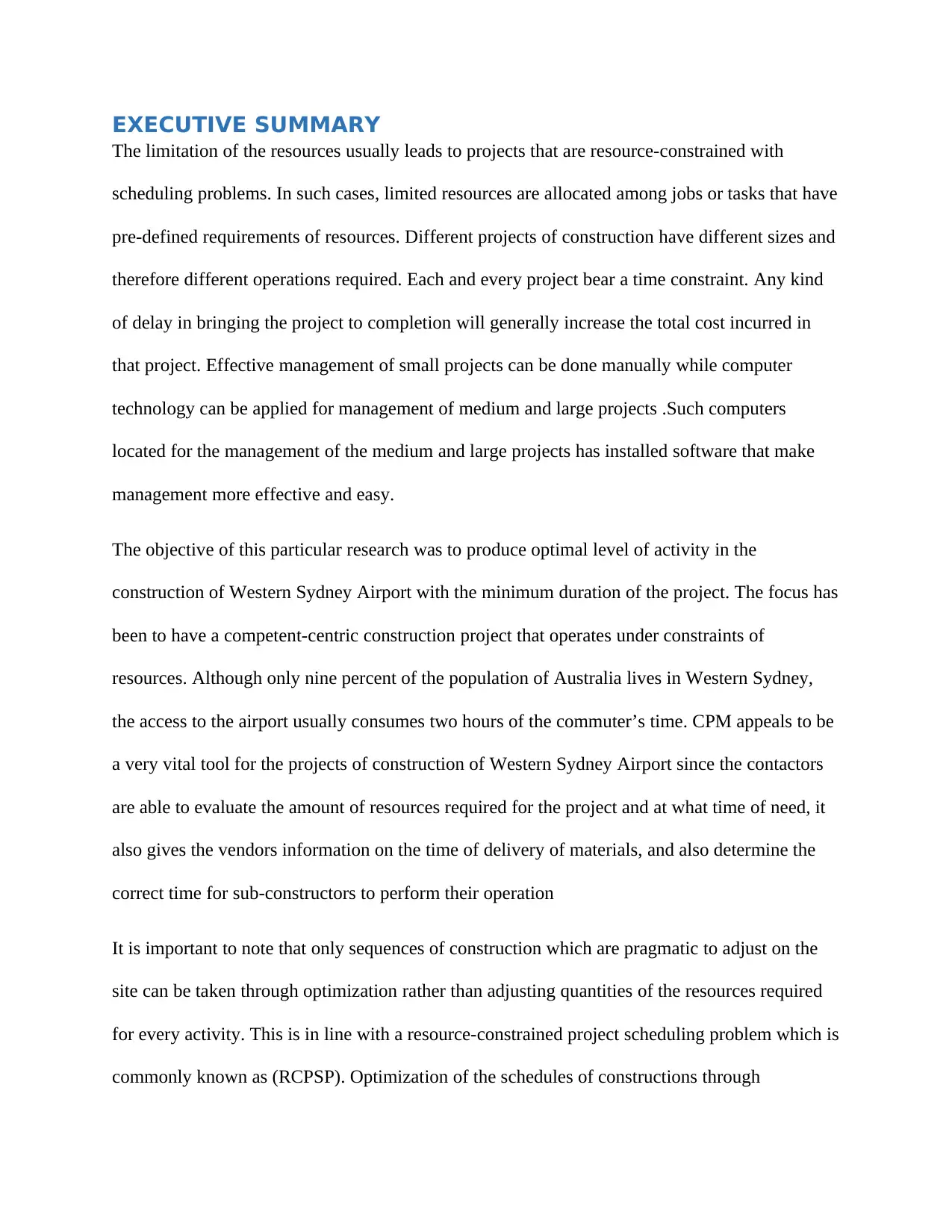
EXECUTIVE SUMMARY
The limitation of the resources usually leads to projects that are resource-constrained with
scheduling problems. In such cases, limited resources are allocated among jobs or tasks that have
pre-defined requirements of resources. Different projects of construction have different sizes and
therefore different operations required. Each and every project bear a time constraint. Any kind
of delay in bringing the project to completion will generally increase the total cost incurred in
that project. Effective management of small projects can be done manually while computer
technology can be applied for management of medium and large projects .Such computers
located for the management of the medium and large projects has installed software that make
management more effective and easy.
The objective of this particular research was to produce optimal level of activity in the
construction of Western Sydney Airport with the minimum duration of the project. The focus has
been to have a competent-centric construction project that operates under constraints of
resources. Although only nine percent of the population of Australia lives in Western Sydney,
the access to the airport usually consumes two hours of the commuter’s time. CPM appeals to be
a very vital tool for the projects of construction of Western Sydney Airport since the contactors
are able to evaluate the amount of resources required for the project and at what time of need, it
also gives the vendors information on the time of delivery of materials, and also determine the
correct time for sub-constructors to perform their operation
It is important to note that only sequences of construction which are pragmatic to adjust on the
site can be taken through optimization rather than adjusting quantities of the resources required
for every activity. This is in line with a resource-constrained project scheduling problem which is
commonly known as (RCPSP). Optimization of the schedules of constructions through
The limitation of the resources usually leads to projects that are resource-constrained with
scheduling problems. In such cases, limited resources are allocated among jobs or tasks that have
pre-defined requirements of resources. Different projects of construction have different sizes and
therefore different operations required. Each and every project bear a time constraint. Any kind
of delay in bringing the project to completion will generally increase the total cost incurred in
that project. Effective management of small projects can be done manually while computer
technology can be applied for management of medium and large projects .Such computers
located for the management of the medium and large projects has installed software that make
management more effective and easy.
The objective of this particular research was to produce optimal level of activity in the
construction of Western Sydney Airport with the minimum duration of the project. The focus has
been to have a competent-centric construction project that operates under constraints of
resources. Although only nine percent of the population of Australia lives in Western Sydney,
the access to the airport usually consumes two hours of the commuter’s time. CPM appeals to be
a very vital tool for the projects of construction of Western Sydney Airport since the contactors
are able to evaluate the amount of resources required for the project and at what time of need, it
also gives the vendors information on the time of delivery of materials, and also determine the
correct time for sub-constructors to perform their operation
It is important to note that only sequences of construction which are pragmatic to adjust on the
site can be taken through optimization rather than adjusting quantities of the resources required
for every activity. This is in line with a resource-constrained project scheduling problem which is
commonly known as (RCPSP). Optimization of the schedules of constructions through
Paraphrase This Document
Need a fresh take? Get an instant paraphrase of this document with our AI Paraphraser

adjustments of the required resources has been targeted by this particular paper. The study has
chosen the approach of CPS in the management of the Western Sydney Airport Construction
Schedules. The approach of CPS is regarded to be a scheduling approach that entails a lot of
information vital for documenting as well as analyzing built schedules.
Operation of CPs can therefore be excellent in support of the employed efforts to obtain low
granularity levels that will enable an efficient control of the project by means of managing the
available resources properly, analysis on delays, taking records on events at site and corrective
measures (Doench et al.2016). The process of construction is viewed to be a group of operations
that bear inter-relations, including the roles played by a worker, Both skilled and non-skilled
applying the currently available technologies and skills such as use of machines, software
chemicals among others, in a desired and more effective manner, for which in any case there is
failure will bring the process of construction to a standstill resulting into delay. The disparity
between CPS and CPM prove therefore to be the same to that between detailed shop drawings
and design drawings applied in the course of construction processes. The approach used has been
found fit for the optimization program in the construction schedule of Western Sydney Airport.
Introduction
Aviation is very important to the prosperity and growth of Australia. Residents, tourists and
businesses rely on accessing efficient, fast and reliable services of aviation. Australia Western
Sydney airport has been handling a population of almost 2 million. This figure is expected to
chosen the approach of CPS in the management of the Western Sydney Airport Construction
Schedules. The approach of CPS is regarded to be a scheduling approach that entails a lot of
information vital for documenting as well as analyzing built schedules.
Operation of CPs can therefore be excellent in support of the employed efforts to obtain low
granularity levels that will enable an efficient control of the project by means of managing the
available resources properly, analysis on delays, taking records on events at site and corrective
measures (Doench et al.2016). The process of construction is viewed to be a group of operations
that bear inter-relations, including the roles played by a worker, Both skilled and non-skilled
applying the currently available technologies and skills such as use of machines, software
chemicals among others, in a desired and more effective manner, for which in any case there is
failure will bring the process of construction to a standstill resulting into delay. The disparity
between CPS and CPM prove therefore to be the same to that between detailed shop drawings
and design drawings applied in the course of construction processes. The approach used has been
found fit for the optimization program in the construction schedule of Western Sydney Airport.
Introduction
Aviation is very important to the prosperity and growth of Australia. Residents, tourists and
businesses rely on accessing efficient, fast and reliable services of aviation. Australia Western
Sydney airport has been handling a population of almost 2 million. This figure is expected to
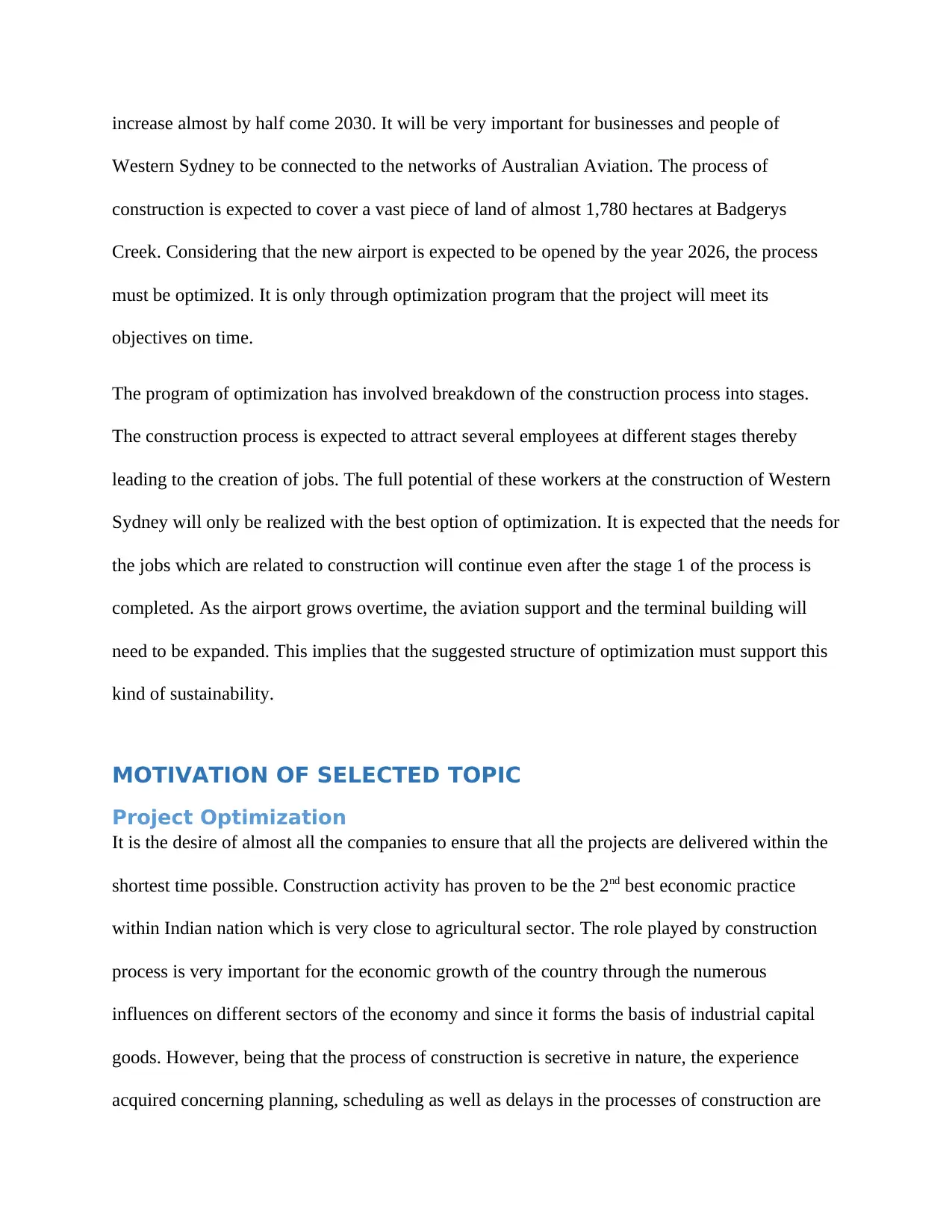
increase almost by half come 2030. It will be very important for businesses and people of
Western Sydney to be connected to the networks of Australian Aviation. The process of
construction is expected to cover a vast piece of land of almost 1,780 hectares at Badgerys
Creek. Considering that the new airport is expected to be opened by the year 2026, the process
must be optimized. It is only through optimization program that the project will meet its
objectives on time.
The program of optimization has involved breakdown of the construction process into stages.
The construction process is expected to attract several employees at different stages thereby
leading to the creation of jobs. The full potential of these workers at the construction of Western
Sydney will only be realized with the best option of optimization. It is expected that the needs for
the jobs which are related to construction will continue even after the stage 1 of the process is
completed. As the airport grows overtime, the aviation support and the terminal building will
need to be expanded. This implies that the suggested structure of optimization must support this
kind of sustainability.
MOTIVATION OF SELECTED TOPIC
Project Optimization
It is the desire of almost all the companies to ensure that all the projects are delivered within the
shortest time possible. Construction activity has proven to be the 2nd best economic practice
within Indian nation which is very close to agricultural sector. The role played by construction
process is very important for the economic growth of the country through the numerous
influences on different sectors of the economy and since it forms the basis of industrial capital
goods. However, being that the process of construction is secretive in nature, the experience
acquired concerning planning, scheduling as well as delays in the processes of construction are
Western Sydney to be connected to the networks of Australian Aviation. The process of
construction is expected to cover a vast piece of land of almost 1,780 hectares at Badgerys
Creek. Considering that the new airport is expected to be opened by the year 2026, the process
must be optimized. It is only through optimization program that the project will meet its
objectives on time.
The program of optimization has involved breakdown of the construction process into stages.
The construction process is expected to attract several employees at different stages thereby
leading to the creation of jobs. The full potential of these workers at the construction of Western
Sydney will only be realized with the best option of optimization. It is expected that the needs for
the jobs which are related to construction will continue even after the stage 1 of the process is
completed. As the airport grows overtime, the aviation support and the terminal building will
need to be expanded. This implies that the suggested structure of optimization must support this
kind of sustainability.
MOTIVATION OF SELECTED TOPIC
Project Optimization
It is the desire of almost all the companies to ensure that all the projects are delivered within the
shortest time possible. Construction activity has proven to be the 2nd best economic practice
within Indian nation which is very close to agricultural sector. The role played by construction
process is very important for the economic growth of the country through the numerous
influences on different sectors of the economy and since it forms the basis of industrial capital
goods. However, being that the process of construction is secretive in nature, the experience
acquired concerning planning, scheduling as well as delays in the processes of construction are
⊘ This is a preview!⊘
Do you want full access?
Subscribe today to unlock all pages.

Trusted by 1+ million students worldwide
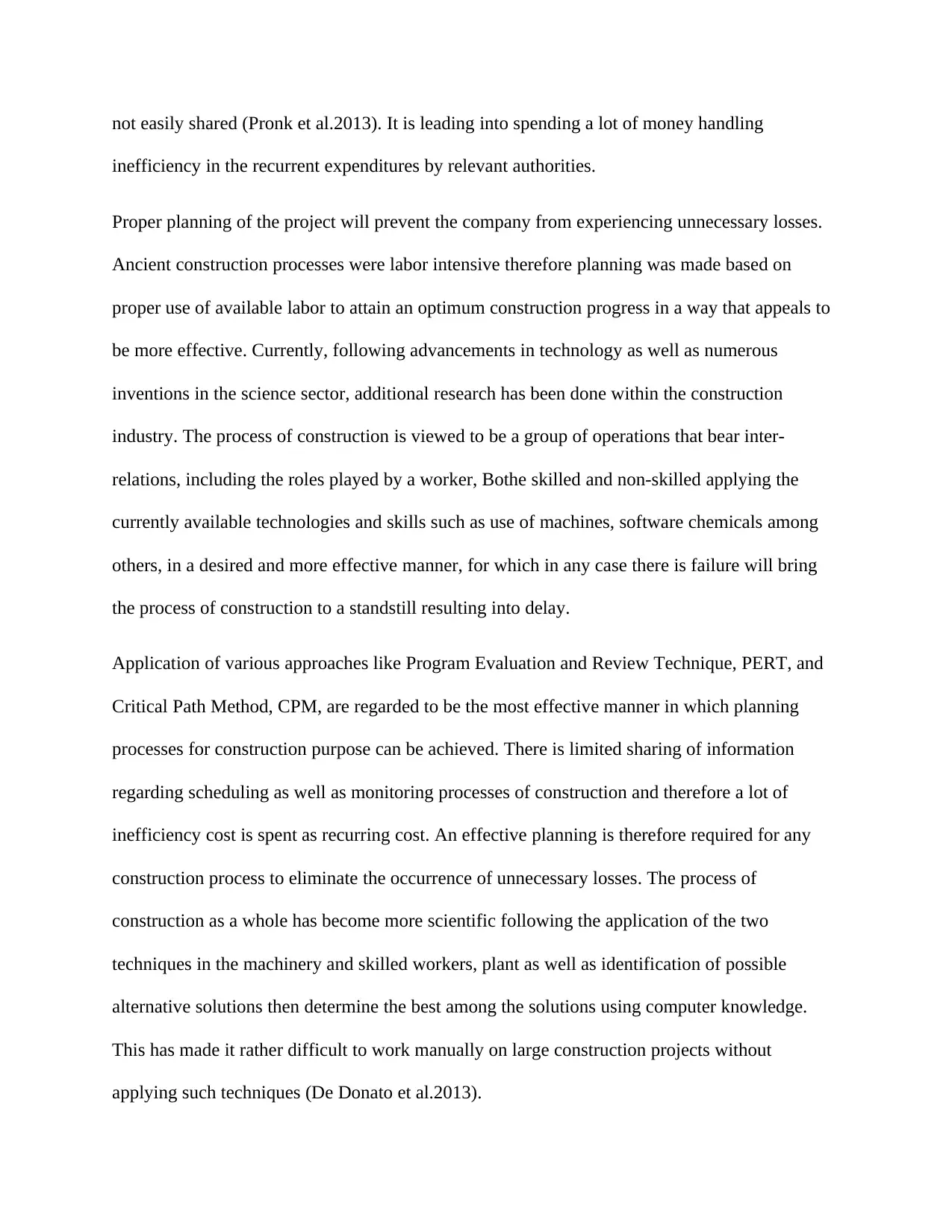
not easily shared (Pronk et al.2013). It is leading into spending a lot of money handling
inefficiency in the recurrent expenditures by relevant authorities.
Proper planning of the project will prevent the company from experiencing unnecessary losses.
Ancient construction processes were labor intensive therefore planning was made based on
proper use of available labor to attain an optimum construction progress in a way that appeals to
be more effective. Currently, following advancements in technology as well as numerous
inventions in the science sector, additional research has been done within the construction
industry. The process of construction is viewed to be a group of operations that bear inter-
relations, including the roles played by a worker, Bothe skilled and non-skilled applying the
currently available technologies and skills such as use of machines, software chemicals among
others, in a desired and more effective manner, for which in any case there is failure will bring
the process of construction to a standstill resulting into delay.
Application of various approaches like Program Evaluation and Review Technique, PERT, and
Critical Path Method, CPM, are regarded to be the most effective manner in which planning
processes for construction purpose can be achieved. There is limited sharing of information
regarding scheduling as well as monitoring processes of construction and therefore a lot of
inefficiency cost is spent as recurring cost. An effective planning is therefore required for any
construction process to eliminate the occurrence of unnecessary losses. The process of
construction as a whole has become more scientific following the application of the two
techniques in the machinery and skilled workers, plant as well as identification of possible
alternative solutions then determine the best among the solutions using computer knowledge.
This has made it rather difficult to work manually on large construction projects without
applying such techniques (De Donato et al.2013).
inefficiency in the recurrent expenditures by relevant authorities.
Proper planning of the project will prevent the company from experiencing unnecessary losses.
Ancient construction processes were labor intensive therefore planning was made based on
proper use of available labor to attain an optimum construction progress in a way that appeals to
be more effective. Currently, following advancements in technology as well as numerous
inventions in the science sector, additional research has been done within the construction
industry. The process of construction is viewed to be a group of operations that bear inter-
relations, including the roles played by a worker, Bothe skilled and non-skilled applying the
currently available technologies and skills such as use of machines, software chemicals among
others, in a desired and more effective manner, for which in any case there is failure will bring
the process of construction to a standstill resulting into delay.
Application of various approaches like Program Evaluation and Review Technique, PERT, and
Critical Path Method, CPM, are regarded to be the most effective manner in which planning
processes for construction purpose can be achieved. There is limited sharing of information
regarding scheduling as well as monitoring processes of construction and therefore a lot of
inefficiency cost is spent as recurring cost. An effective planning is therefore required for any
construction process to eliminate the occurrence of unnecessary losses. The process of
construction as a whole has become more scientific following the application of the two
techniques in the machinery and skilled workers, plant as well as identification of possible
alternative solutions then determine the best among the solutions using computer knowledge.
This has made it rather difficult to work manually on large construction projects without
applying such techniques (De Donato et al.2013).
Paraphrase This Document
Need a fresh take? Get an instant paraphrase of this document with our AI Paraphraser

Optimization Objectives
The main aim of any unit of construction is to ensure completion of the work as stipulated on
schedule and as per the proposed budget under the utilization of the available resources properly
such as capital, machinery, man power, materials and other construction requirements.
To ensure that the goal is met, planning process should major on economical execution of the
project based on time and money spent. An actual report on progress of laborers as well as initial
work schedule must be present for the purpose of updating the process of construction (Fan, Xiao
and Zhao 2017). The progress can either lag behind or as well be a head of the initial work
schedule. The process of construction can be updated using various software like Primavera or
Microsoft Project (MSP). This study mainly aims at providing the analysis on planning,
scheduling as well as delay issued in the construction process of an apartment. The study aims at
providing the analysis on planning and scheduling as well as delay on various activities of the
project performed by use of MS Excel software and MS project, the software is responsible for
the allocation and determination of manpower on every activity carried out. Calculations of labor
requirements for any performed action are done from the standards extracted from the site.
Analysis on the delay in completion of the project is obtained through an updated schedule that
assists in completion of the project in time without wastage of resources. All these are addressed
within the span of this study.
METHODS OF SELECTED ENGINEERING TOPIC
Review of impacts of Planning, Scheduling and Delay on the optimization
process
The work that has been presented by different authors mainly concentrates on the benefits of
planning, scheduling as well as delay analysis and also on proper usage of the available
construction resources. Some scholars in their report stated that no great concern has been made
The main aim of any unit of construction is to ensure completion of the work as stipulated on
schedule and as per the proposed budget under the utilization of the available resources properly
such as capital, machinery, man power, materials and other construction requirements.
To ensure that the goal is met, planning process should major on economical execution of the
project based on time and money spent. An actual report on progress of laborers as well as initial
work schedule must be present for the purpose of updating the process of construction (Fan, Xiao
and Zhao 2017). The progress can either lag behind or as well be a head of the initial work
schedule. The process of construction can be updated using various software like Primavera or
Microsoft Project (MSP). This study mainly aims at providing the analysis on planning,
scheduling as well as delay issued in the construction process of an apartment. The study aims at
providing the analysis on planning and scheduling as well as delay on various activities of the
project performed by use of MS Excel software and MS project, the software is responsible for
the allocation and determination of manpower on every activity carried out. Calculations of labor
requirements for any performed action are done from the standards extracted from the site.
Analysis on the delay in completion of the project is obtained through an updated schedule that
assists in completion of the project in time without wastage of resources. All these are addressed
within the span of this study.
METHODS OF SELECTED ENGINEERING TOPIC
Review of impacts of Planning, Scheduling and Delay on the optimization
process
The work that has been presented by different authors mainly concentrates on the benefits of
planning, scheduling as well as delay analysis and also on proper usage of the available
construction resources. Some scholars in their report stated that no great concern has been made
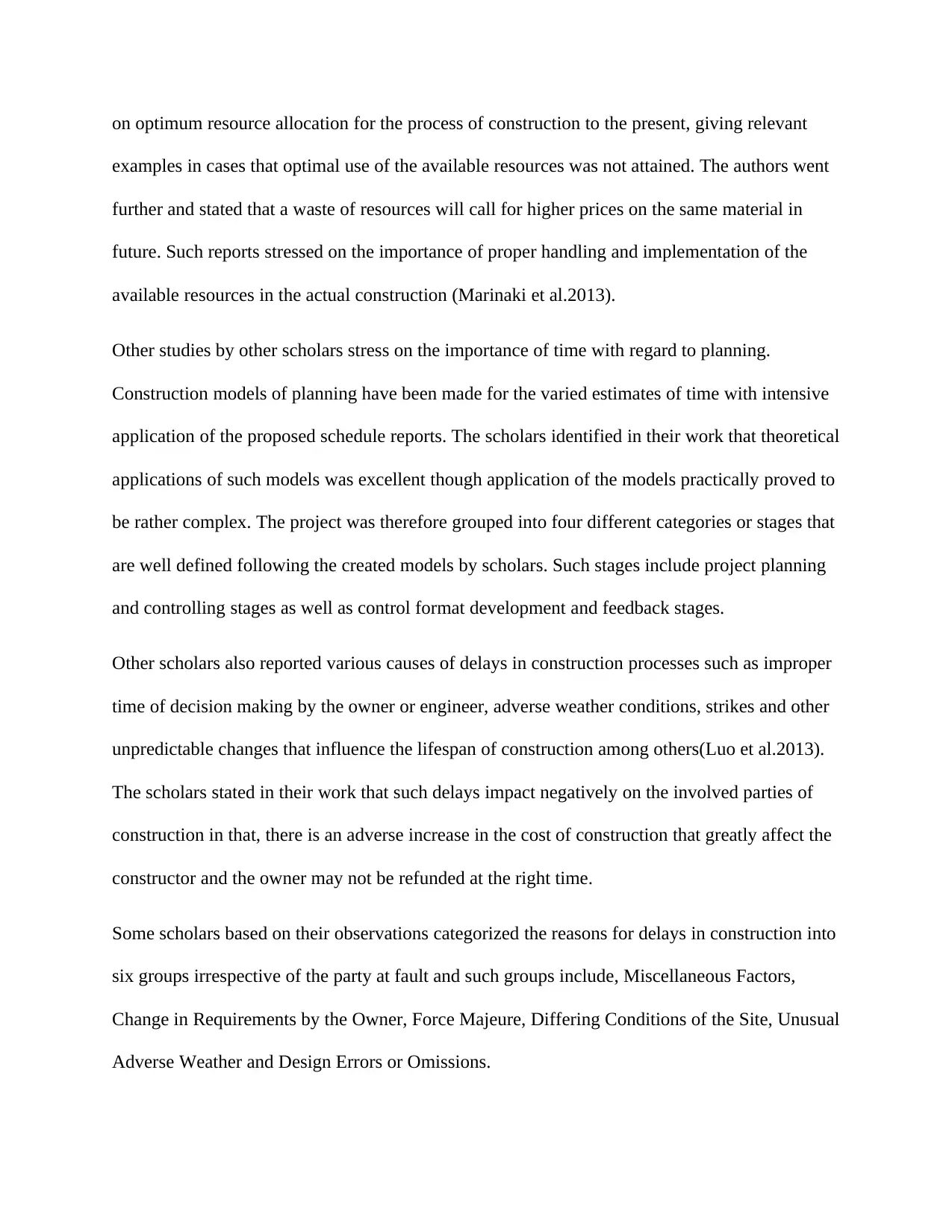
on optimum resource allocation for the process of construction to the present, giving relevant
examples in cases that optimal use of the available resources was not attained. The authors went
further and stated that a waste of resources will call for higher prices on the same material in
future. Such reports stressed on the importance of proper handling and implementation of the
available resources in the actual construction (Marinaki et al.2013).
Other studies by other scholars stress on the importance of time with regard to planning.
Construction models of planning have been made for the varied estimates of time with intensive
application of the proposed schedule reports. The scholars identified in their work that theoretical
applications of such models was excellent though application of the models practically proved to
be rather complex. The project was therefore grouped into four different categories or stages that
are well defined following the created models by scholars. Such stages include project planning
and controlling stages as well as control format development and feedback stages.
Other scholars also reported various causes of delays in construction processes such as improper
time of decision making by the owner or engineer, adverse weather conditions, strikes and other
unpredictable changes that influence the lifespan of construction among others(Luo et al.2013).
The scholars stated in their work that such delays impact negatively on the involved parties of
construction in that, there is an adverse increase in the cost of construction that greatly affect the
constructor and the owner may not be refunded at the right time.
Some scholars based on their observations categorized the reasons for delays in construction into
six groups irrespective of the party at fault and such groups include, Miscellaneous Factors,
Change in Requirements by the Owner, Force Majeure, Differing Conditions of the Site, Unusual
Adverse Weather and Design Errors or Omissions.
examples in cases that optimal use of the available resources was not attained. The authors went
further and stated that a waste of resources will call for higher prices on the same material in
future. Such reports stressed on the importance of proper handling and implementation of the
available resources in the actual construction (Marinaki et al.2013).
Other studies by other scholars stress on the importance of time with regard to planning.
Construction models of planning have been made for the varied estimates of time with intensive
application of the proposed schedule reports. The scholars identified in their work that theoretical
applications of such models was excellent though application of the models practically proved to
be rather complex. The project was therefore grouped into four different categories or stages that
are well defined following the created models by scholars. Such stages include project planning
and controlling stages as well as control format development and feedback stages.
Other scholars also reported various causes of delays in construction processes such as improper
time of decision making by the owner or engineer, adverse weather conditions, strikes and other
unpredictable changes that influence the lifespan of construction among others(Luo et al.2013).
The scholars stated in their work that such delays impact negatively on the involved parties of
construction in that, there is an adverse increase in the cost of construction that greatly affect the
constructor and the owner may not be refunded at the right time.
Some scholars based on their observations categorized the reasons for delays in construction into
six groups irrespective of the party at fault and such groups include, Miscellaneous Factors,
Change in Requirements by the Owner, Force Majeure, Differing Conditions of the Site, Unusual
Adverse Weather and Design Errors or Omissions.
⊘ This is a preview!⊘
Do you want full access?
Subscribe today to unlock all pages.

Trusted by 1+ million students worldwide
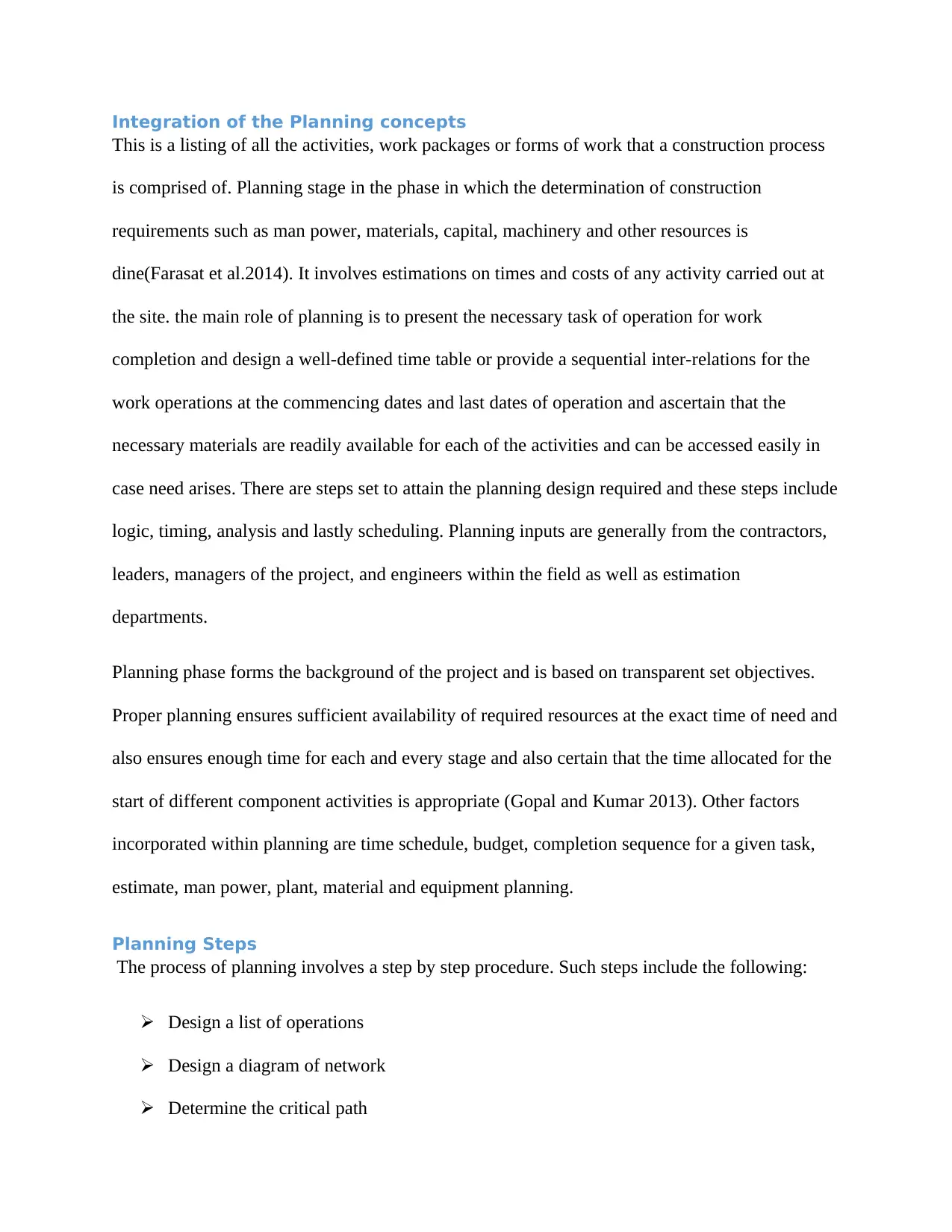
Integration of the Planning concepts
This is a listing of all the activities, work packages or forms of work that a construction process
is comprised of. Planning stage in the phase in which the determination of construction
requirements such as man power, materials, capital, machinery and other resources is
dine(Farasat et al.2014). It involves estimations on times and costs of any activity carried out at
the site. the main role of planning is to present the necessary task of operation for work
completion and design a well-defined time table or provide a sequential inter-relations for the
work operations at the commencing dates and last dates of operation and ascertain that the
necessary materials are readily available for each of the activities and can be accessed easily in
case need arises. There are steps set to attain the planning design required and these steps include
logic, timing, analysis and lastly scheduling. Planning inputs are generally from the contractors,
leaders, managers of the project, and engineers within the field as well as estimation
departments.
Planning phase forms the background of the project and is based on transparent set objectives.
Proper planning ensures sufficient availability of required resources at the exact time of need and
also ensures enough time for each and every stage and also certain that the time allocated for the
start of different component activities is appropriate (Gopal and Kumar 2013). Other factors
incorporated within planning are time schedule, budget, completion sequence for a given task,
estimate, man power, plant, material and equipment planning.
Planning Steps
The process of planning involves a step by step procedure. Such steps include the following:
Design a list of operations
Design a diagram of network
Determine the critical path
This is a listing of all the activities, work packages or forms of work that a construction process
is comprised of. Planning stage in the phase in which the determination of construction
requirements such as man power, materials, capital, machinery and other resources is
dine(Farasat et al.2014). It involves estimations on times and costs of any activity carried out at
the site. the main role of planning is to present the necessary task of operation for work
completion and design a well-defined time table or provide a sequential inter-relations for the
work operations at the commencing dates and last dates of operation and ascertain that the
necessary materials are readily available for each of the activities and can be accessed easily in
case need arises. There are steps set to attain the planning design required and these steps include
logic, timing, analysis and lastly scheduling. Planning inputs are generally from the contractors,
leaders, managers of the project, and engineers within the field as well as estimation
departments.
Planning phase forms the background of the project and is based on transparent set objectives.
Proper planning ensures sufficient availability of required resources at the exact time of need and
also ensures enough time for each and every stage and also certain that the time allocated for the
start of different component activities is appropriate (Gopal and Kumar 2013). Other factors
incorporated within planning are time schedule, budget, completion sequence for a given task,
estimate, man power, plant, material and equipment planning.
Planning Steps
The process of planning involves a step by step procedure. Such steps include the following:
Design a list of operations
Design a diagram of network
Determine the critical path
Paraphrase This Document
Need a fresh take? Get an instant paraphrase of this document with our AI Paraphraser
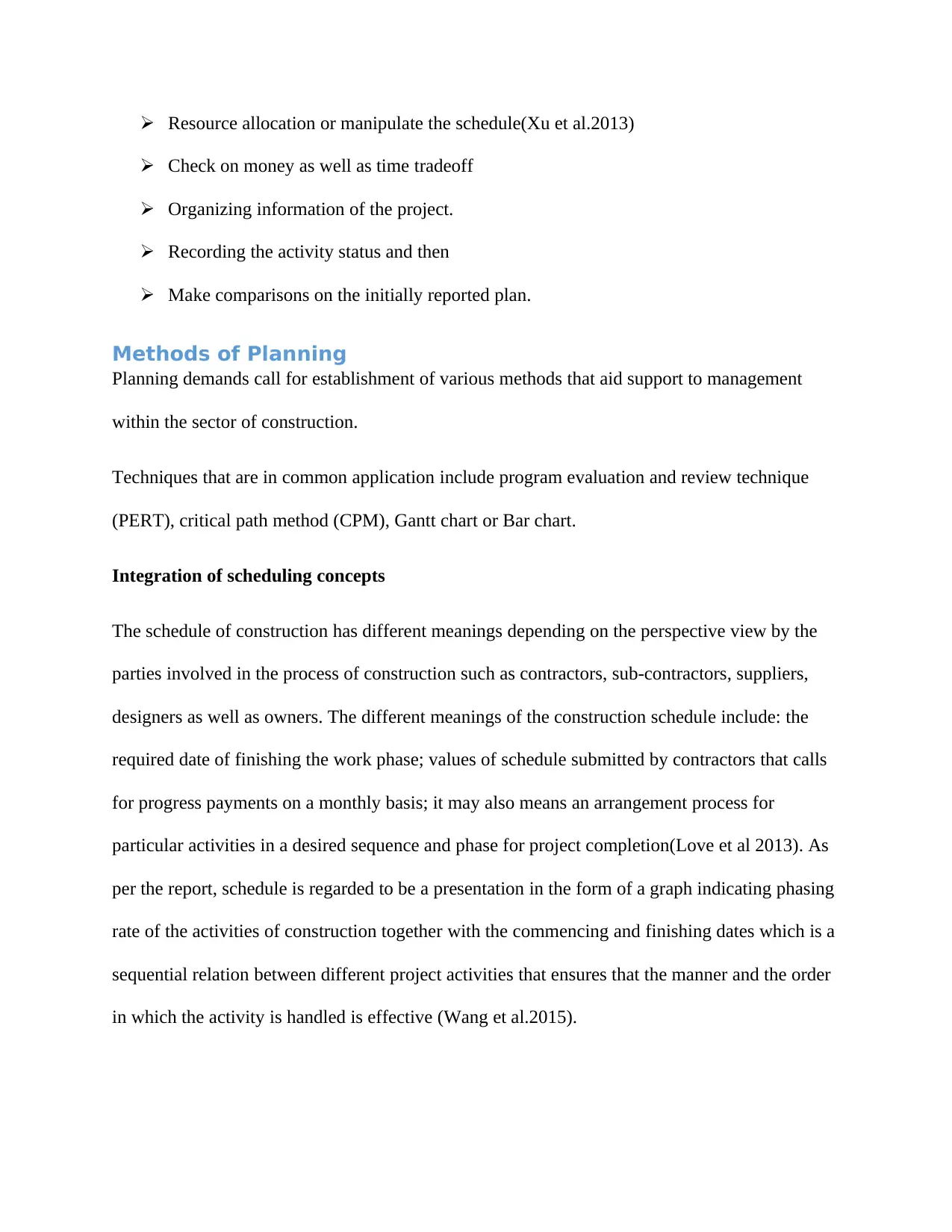
Resource allocation or manipulate the schedule(Xu et al.2013)
Check on money as well as time tradeoff
Organizing information of the project.
Recording the activity status and then
Make comparisons on the initially reported plan.
Methods of Planning
Planning demands call for establishment of various methods that aid support to management
within the sector of construction.
Techniques that are in common application include program evaluation and review technique
(PERT), critical path method (CPM), Gantt chart or Bar chart.
Integration of scheduling concepts
The schedule of construction has different meanings depending on the perspective view by the
parties involved in the process of construction such as contractors, sub-contractors, suppliers,
designers as well as owners. The different meanings of the construction schedule include: the
required date of finishing the work phase; values of schedule submitted by contractors that calls
for progress payments on a monthly basis; it may also means an arrangement process for
particular activities in a desired sequence and phase for project completion(Love et al 2013). As
per the report, schedule is regarded to be a presentation in the form of a graph indicating phasing
rate of the activities of construction together with the commencing and finishing dates which is a
sequential relation between different project activities that ensures that the manner and the order
in which the activity is handled is effective (Wang et al.2015).
Check on money as well as time tradeoff
Organizing information of the project.
Recording the activity status and then
Make comparisons on the initially reported plan.
Methods of Planning
Planning demands call for establishment of various methods that aid support to management
within the sector of construction.
Techniques that are in common application include program evaluation and review technique
(PERT), critical path method (CPM), Gantt chart or Bar chart.
Integration of scheduling concepts
The schedule of construction has different meanings depending on the perspective view by the
parties involved in the process of construction such as contractors, sub-contractors, suppliers,
designers as well as owners. The different meanings of the construction schedule include: the
required date of finishing the work phase; values of schedule submitted by contractors that calls
for progress payments on a monthly basis; it may also means an arrangement process for
particular activities in a desired sequence and phase for project completion(Love et al 2013). As
per the report, schedule is regarded to be a presentation in the form of a graph indicating phasing
rate of the activities of construction together with the commencing and finishing dates which is a
sequential relation between different project activities that ensures that the manner and the order
in which the activity is handled is effective (Wang et al.2015).

Steps involved in scheduling
Construction schedule is regarded to be a timetable of the project or as a calendaring that shows
the dates of the activities performed within the construction process. The steps involved in
scheduling include: required time estimation for each and every operation (Liu, Xu and Cheung
2014). By use of such estimations of time, determine the overall time required to bring the
construction process to completion, identify time estimation intervals for the start and
completion of each and every activity which comply with the last date of the project, estimate the
amount of work for every component used in the activity, identify operations with crucial
expedient execution to the proposed time of completing the project, in case there is variation in
the date of completion of the project to other requirements or the contract itself, the duration of
the project should be squeezed at the lowest cost possible(Rysanek and Choudhary 2013). The
analysis on planning, scheduling and delay has proven to be of benefit and more crucial part of
any given project that ensure that the project is complete in either economical or time
manner(Teizer, Cheng, and Fang 2013). A well construction schedule has the ability to perform
numerous functions. Through application of a construction schedule to foretell the completion of
any project, constructors are in position to adjust as per the recommendations using the available
equipment to regulate the progress of work.
Different projects of construction have different sizes and therefore different operations
required. Each and every project bear a time constraint. Any kind of delay in bringing the project
to completion will generally increase the total cost incurred in that project. Effective
management of small projects can be done manually while computer technology can be applied
for management of medium and large projects (Doench et al.2016). Such computers located for
the management of the medium and large projects has installed software that make management
more effective and easy.
Construction schedule is regarded to be a timetable of the project or as a calendaring that shows
the dates of the activities performed within the construction process. The steps involved in
scheduling include: required time estimation for each and every operation (Liu, Xu and Cheung
2014). By use of such estimations of time, determine the overall time required to bring the
construction process to completion, identify time estimation intervals for the start and
completion of each and every activity which comply with the last date of the project, estimate the
amount of work for every component used in the activity, identify operations with crucial
expedient execution to the proposed time of completing the project, in case there is variation in
the date of completion of the project to other requirements or the contract itself, the duration of
the project should be squeezed at the lowest cost possible(Rysanek and Choudhary 2013). The
analysis on planning, scheduling and delay has proven to be of benefit and more crucial part of
any given project that ensure that the project is complete in either economical or time
manner(Teizer, Cheng, and Fang 2013). A well construction schedule has the ability to perform
numerous functions. Through application of a construction schedule to foretell the completion of
any project, constructors are in position to adjust as per the recommendations using the available
equipment to regulate the progress of work.
Different projects of construction have different sizes and therefore different operations
required. Each and every project bear a time constraint. Any kind of delay in bringing the project
to completion will generally increase the total cost incurred in that project. Effective
management of small projects can be done manually while computer technology can be applied
for management of medium and large projects (Doench et al.2016). Such computers located for
the management of the medium and large projects has installed software that make management
more effective and easy.
⊘ This is a preview!⊘
Do you want full access?
Subscribe today to unlock all pages.

Trusted by 1+ million students worldwide
1 out of 25
Related Documents
Your All-in-One AI-Powered Toolkit for Academic Success.
+13062052269
info@desklib.com
Available 24*7 on WhatsApp / Email
![[object Object]](/_next/static/media/star-bottom.7253800d.svg)
Unlock your academic potential
Copyright © 2020–2025 A2Z Services. All Rights Reserved. Developed and managed by ZUCOL.




